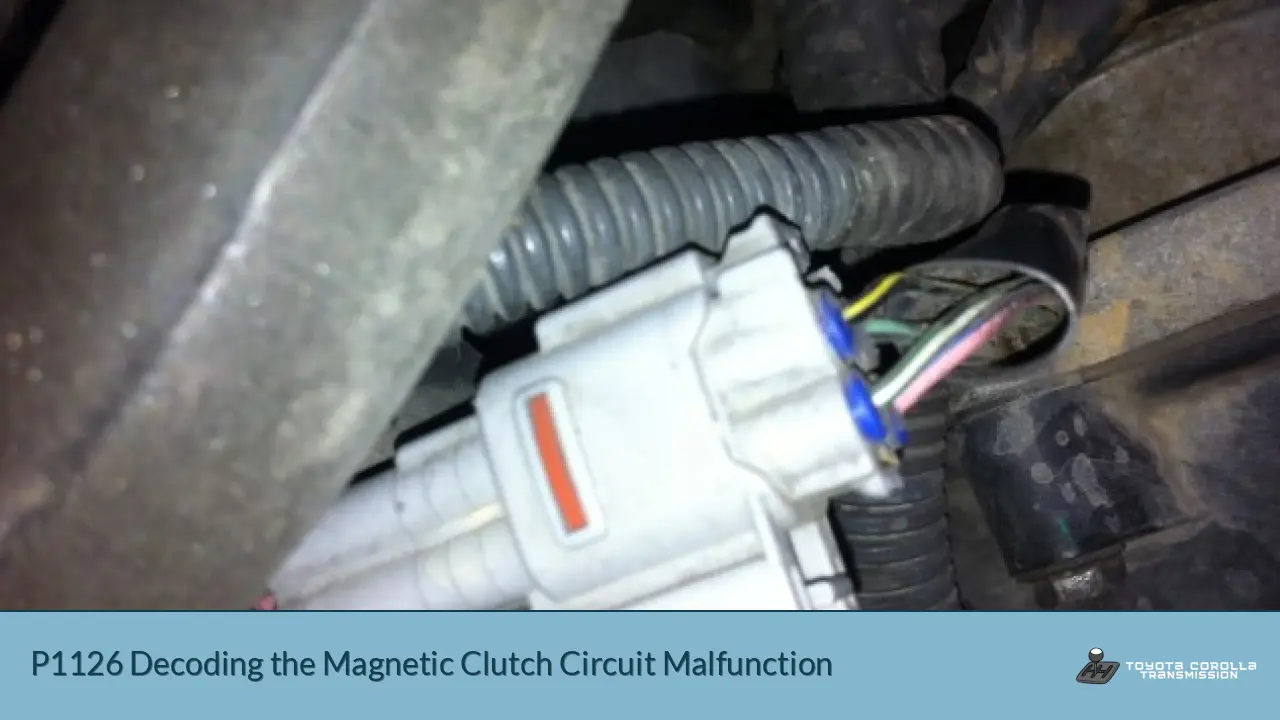The P1126 error code in Toyota vehicles indicates a malfunction in the magnetic clutch circuit. This issue, while not immediately catastrophic, can lead to significant problems if left unaddressed. Understanding the intricacies of this error code is crucial for proper diagnosis and timely repair.
| Aspect | Details | Possible Causes |
|---|---|---|
| Definition | Magnetic Clutch Circuit Malfunction | Wiring issues, faulty magnetic clutch, ECM problems |
| Severity | Moderate | Can lead to drivability issues if not addressed |
| Common Symptoms | Check Engine Light, reduced throttle response | Intermittent power loss, limp mode activation |
Understanding the Magnetic Clutch
The magnetic clutch plays a vital role in the electronic throttle control system of modern Toyota vehicles. It’s responsible for connecting the throttle motor to the throttle valve, allowing precise control over engine performance and fuel efficiency.
Function of the Magnetic Clutch
The magnetic clutch acts as a safety mechanism, designed to decouple the throttle motor from the valve in case of system malfunction. This prevents unintended acceleration and ensures driver safety. When functioning correctly, it enables smooth throttle operation and contributes to the vehicle’s overall performance.
Symptoms of P1126
When the P1126 code appears, drivers may experience several symptoms:
- Illuminated Check Engine Light: This is often the first sign of trouble.
- Reduced Throttle Response: The vehicle may feel sluggish or unresponsive.
- Intermittent Power Loss: Engine power may fluctuate unexpectedly.
- Activation of Limp Mode: In some cases, the vehicle may enter a reduced power mode for safety.
Diagnosing P1126
Proper diagnosis of the P1126 code requires a systematic approach:
- Scan for Additional Codes: Other related codes may provide more context.
- Visual Inspection: Check for obvious wiring issues or damage.
- Resistance Testing: Measure the magnetic clutch’s resistance.
- Voltage Testing: Ensure proper voltage supply to the clutch.
Common Causes of P1126
Several factors can trigger the P1126 code:
- Wiring Issues: Damaged or corroded wires in the clutch circuit.
- Faulty Magnetic Clutch: The clutch itself may be defective.
- ECM Problems: In rare cases, the Engine Control Module may be at fault.
- Throttle Body Issues: A malfunctioning throttle body can trigger this code.
Resolving P1126
Fixing the P1126 error often involves the following steps:
- Wiring Repair: Address any visible wiring problems.
- Magnetic Clutch Replacement: If faulty, replace the entire unit.
- Throttle Body Cleaning or Replacement: Sometimes necessary for a complete fix.
- ECM Reprogramming or Replacement: In extreme cases, the ECM may need attention.
DIY vs. Professional Repair
While some aspects of diagnosis can be performed at home, professional assistance is often necessary for a complete and accurate repair. The complexity of modern vehicle electronics makes it challenging for most DIY enthusiasts to fully address this issue.
Preventing Future Occurrences
To avoid future P1126 codes:
- Regular Maintenance: Follow Toyota’s recommended service schedule.
- Prompt Attention to Warning Signs: Address any performance issues immediately.
- Quality Parts: Use OEM or high-quality aftermarket parts for replacements.
Long-Term Implications
Ignoring the P1126 code can lead to:
- Reduced Fuel Efficiency: The engine may not operate at optimal levels.
- Increased Emissions: Potentially failing emissions tests.
- Further System Damage: Other components may be affected over time.
FAQs
What does the P1126 code mean for my Toyota?
It indicates a problem with the magnetic clutch circuit in the throttle control system. This can affect throttle response and overall engine performance.
Can I still drive with a P1126 code?
While possible, it’s not recommended. The vehicle may enter limp mode or experience reduced performance, potentially compromising safety.
How much does it cost to fix a P1126 error?
Costs vary depending on the root cause, ranging from $100 for simple repairs to $1000+ for more complex issues involving the throttle body or ECM.
Is P1126 a serious problem?
While not immediately critical, it should be addressed promptly to prevent potential drivability issues and further damage.
Can P1126 be fixed at home?
Basic diagnostics can be done at home, but professional repair is often necessary due to the complexity of the system.

